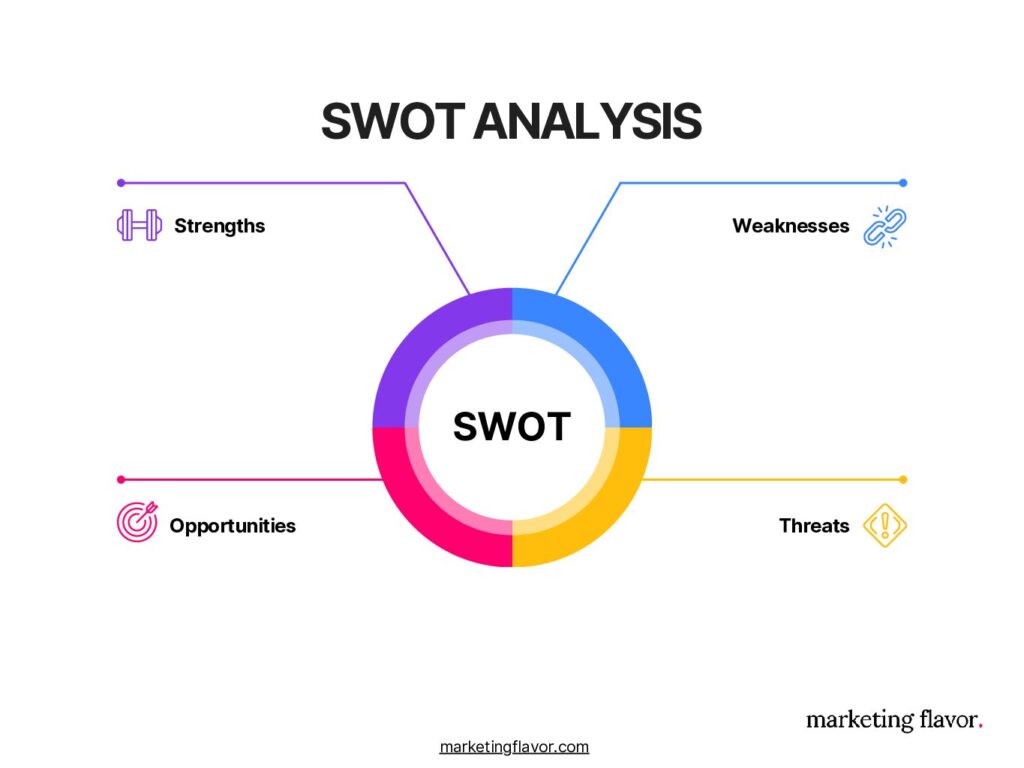When it comes to business planning and decision-making, a SWOT analysis is an invaluable tool that helps organizations assess their internal strengths and weaknesses, as well as external opportunities and threats.
A SWOT analysis involves identifying and evaluating an organization’s strengths, weaknesses, opportunities, and threats.
Hence the name SWOT.
By analyzing these four key aspects, businesses can gain a deeper understanding of their current position and develop strategic plans to achieve their goals.
In this article, we’ll dive into the world of SWOT analysis, discussing its definition, components, and importance.
We’ll also provide examples and a FREE template to help you conduct an effective SWOT analysis for your business.
So, let’s get started!
What is a SWOT Analysis?

A SWOT analysis is a strategic planning tool that helps organizations identify their internal strengths and weaknesses, as well as external opportunities and threats.
The acronym “SWOT” stands for:
Strengths
Weaknesses
Opportunities
Threats
A SWOT analysis involves evaluating these four elements to develop a better understanding of an organization’s current position and to make informed decisions about future strategies.
The strengths and weaknesses are internal factors that can be controlled by the organization, while the opportunities and threats are external factors that may impact the organization but cannot be controlled.
This process can be applied to various aspects of a business, such as marketing, product development, and competitive analysis.
Now, let’s check out how you can do it. Don’t worry; it’s easy; this is one of the most basic marketing analyses and is also super effective too!
How to Do a SWOT Analysis
 Conducting a SWOT analysis is a systematic process that involves gathering information, analyzing data, and making strategic decisions.
Conducting a SWOT analysis is a systematic process that involves gathering information, analyzing data, and making strategic decisions.
Here’s a step-by-step guide to help you perform an analysis for your business.
Step 1: Choose a Focus Area
Identify the specific area of your business that you want to analyze.
This could be a new product or service, a particular department, or your overall business strategy.
For example, if you are a small business, you might want to focus on your online presence and how it compares to your competitors.
Or, if you are a larger company, you might want to focus on a specific product or service line.
Step 2: Assemble a Team
Gather a team of key stakeholders who can provide valuable insights and different perspectives.
This might include managers, employees, and even customers or suppliers.
Or if you’re an entrepreneur or, shall we say, a solo-preneur, turn off your electronic devices, grab a pen and paper, and get honest with yourself.
Step 3: List Your Strengths
Identify and document the internal factors that give your business an advantage over others.
These could be your unique skills, resources, or competitive advantages.
For example, your business might have a strong brand, a loyal customer base, or an innovative product.
Step 4: Identify Your Weaknesses
Next, list the internal factors that place your business at a disadvantage compared to others.
Be honest with this one, c’mon I know you’re biased here, but don’t be.
So, these factors could be areas where you lack resources and skills or have a competitive disadvantage.
For example, your business might have a small marketing budget, outdated technology, or a high employee turnover rate.
Again, be honest; this is a super important step to help you gain clarity around the next steps.
Step 5: Identify Opportunities
Consider external factors that could benefit your business.
These could be emerging trends, market changes, or new technologies.
For example, an opportunity could be the increasing demand for eco-friendly products, or a new partnership that could expand your market reach.
Step 6: Recognize Threats
Lastly, identify external factors that could negatively impact your business.
These could be new competitors, changes in regulations, or economic downturns.
For example, a threat could be a new law that affects your industry, or a larger competitor entering your market.
Again, it’s super important to answer this honestly and list everything that pops into your mind.
Step 7: Review and Refine
Once you have completed your SWOT analysis, review the information with your team and refine your lists.
Focus on the most important and relevant factors for your business and remove any that are less critical.
Ok, you’ve done the hard work; now the fun begins.
Step 8: Develop Strategies
Use your SWOT analysis to develop strategies that capitalize on your strengths, address your weaknesses, take advantage of opportunities, and mitigate threats.
Create specific action plans, assign responsibilities, and set deadlines for each strategy.
This step will be further delved into in future articles, but for now, just get brainstorming with your team!
Step 9: Monitor and Update
Regularly review and update your SWOT analysis to reflect changes in your business environment.
This will help you stay proactive and ensure that your strategies remain relevant and effective.
We’ve found it super helpful to schedule a monthly appointment in the diary for this so we make time to keep on top of the business.
Now, let’s have a look at some examples.
SWOT Analysis Examples

To help you better understand how to perform a SWOT analysis, let’s look at a few examples in different contexts:
- Personal SWOT Analysis: A personal SWOT analysis can help individuals identify their strengths, weaknesses, opportunities, and threats in their career or personal life.
For example, a student might use a personal SWOT analysis to identify their strengths and weaknesses in academics and identify opportunities for internships or threats such as the increasing cost of education.
- Business SWOT Analysis: A business SWOT analysis is a strategic planning tool used by organizations to identify and assess their internal strengths and weaknesses, as well as external opportunities and threats.
A straightforward example is where a small business owner might use a SWOT analysis to identify their company’s strengths and weaknesses, opportunities in the market and potential threats from competitors.
- Marketing SWOT Analysis: A marketing SWOT analysis is a tool used to evaluate a company’s current marketing strategy and identify areas for improvement.
So, a marketing team might use a SWOT analysis to assess the strengths and weaknesses of their marketing campaigns, opportunities for growth in the market, and potential threats from new competitors.
- Competitive SWOT Analysis: A competitive SWOT analysis is used to compare an organization’s strengths, weaknesses, opportunities, and threats to those of its competitors.
For example, a company might use a competitive SWOT analysis to assess how its product offerings compare to those of its competitors, identify areas where they have a competitive advantage and identify potential threats to its market share.
By examining these examples, you can get a better sense of how a SWOT analysis can be applied in different situations, from personal development to business strategy.
How will a SWOT analysis help you and your business? St. Cloud State University showcases a great analysis they did.

SWOT Analysis Template
Check out our template below; it’s free to download, and feel free to share it with your mates!
Just right-click on the graphic below and save it to your computer.

Now, let’s drill down a little further on your analysis.
How to Use a SWOT Analysis for Decision-Making
Ready to make the most out of your hard work and generate some actionable results?
Here are some key steps to effectively use a SWOT analysis for decision-making:
- Focus on Critical Factors: Identify the most important factors in each category.
A critical strength might be your unique product features, while a key opportunity could be an untapped market segment.
- Prioritize: Determine which factors are most significant and should be prioritized in your decision-making process.
This will help you allocate resources and focus on the areas that will have the greatest impact.
- Set Objectives: Use your SWOT analysis to define clear and specific objectives.
If an opportunity is to expand into a new market, set measurable goals for market share and revenue.
- Develop Strategies: Create strategies that leverage your strengths, address your weaknesses, capitalize on opportunities, and mitigate threats.
These strategies should be actionable and aligned with your objectives.
- Monitor Progress: Regularly review your SWOT analysis and the associated strategies to track your progress.
Make adjustments as needed to stay on course and adapt to changes in your business environment.
By following these steps, you can use a SWOT analysis to make well-informed decisions and guide your business toward success.

Last Up
A SWOT analysis is a versatile tool that can be applied to various aspects of your business, from strategic planning to marketing and project management.
By identifying your strengths and weaknesses, as well as opportunities and threats, you can make informed decisions and develop effective strategies to achieve your goals.
Remember that a SWOT analysis is not a one-time exercise, but rather a continuous process that should be revisited regularly to stay proactive and adapt to changes in your business environment.
By incorporating the insights gained from your analysis into your decision-making, you can enhance your business’s competitiveness and drive sustainable growth.
Our friends at OnStrategy help you dive into an analysis, it’s a great vid and you can learn heaps.
Frequently Asked Questions

What are the main components of a SWOT analysis?
The main components of a SWOT analysis are strengths, weaknesses, opportunities, and threats.
Strengths and weaknesses are internal factors that can be controlled by the organization, while opportunities and threats are external factors that may impact the organization but cannot be controlled.
What is the purpose of a SWOT analysis?
The purpose of a SWOT analysis is to help organizations identify their internal strengths and weaknesses, as well as external opportunities and threats.
This analysis provides a comprehensive overview of the organization’s current position, guiding them in developing strategies to capitalize on their strengths, address their weaknesses, take advantage of opportunities, and mitigate potential threats.
How does a SWOT analysis help with strategic planning?
A SWOT analysis helps with strategic planning by providing valuable insights into the organization’s current position and the external factors that may impact its success.
This information is used to develop strategies that leverage the organization’s strengths, address its weaknesses, capitalize on opportunities, and mitigate threats, ultimately guiding the organization towards its strategic goals.
How can a SWOT analysis be used in project management?
In project management, a SWOT analysis can be used to assess the internal and external factors that may impact the success of a project.
By identifying the project’s strengths and weaknesses, as well as the opportunities and threats in the project’s environment, project managers can develop strategies to maximize the project’s chances of success and mitigate potential risks.
What are some SWOT analysis examples?
Some SWOT analysis examples include:
A company conducting a SWOT analysis to assess its competitive position in the market
An individual using a SWOT analysis to evaluate their career path and identify areas for professional development
A non-profit organization performing a SWOT analysis to assess its fundraising strategies and community impact
A project team using a SWOT analysis to identify potential risks and opportunities in their project environment.
What are the limitations of a SWOT analysis?
Some limitations of a SWOT analysis include:
It provides a static view and may not account for changes in the external environment over time.
It may be subjective, as different individuals or teams may have different perspectives on the organization’s strengths, weaknesses, opportunities, and threats.
It may not provide a clear prioritization of factors, making it challenging to determine which ones are most critical for strategic planning.
It may not account for the interconnectedness of factors, as strengths and weaknesses may impact opportunities and threats, and vice versa.










